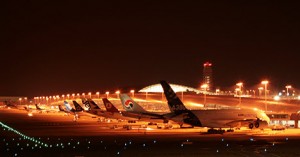
LED lighting is not only more efficient and sustainable, but it is also safer than other available lighting, especially when it comes to airport runway areas. In Ocala, Florida, the Ocala International Airport is beginning to replace its old airfield lighting with high intensity LEDs. Pilots, maintenance crews, and visitors of the airport will experience nightly closures of certain parts of the airport to install the new lighting, but will have a safer, efficient, and more reliable airport, said Sonny Allen, city spokesman. The airport will see new main runway and taxi lighting, directional signage, windsocks, and precision approach path indicators that guide pilots to the runway. The new lighting will also be more accessible than the old lighting, in terms of maintenance. The old system was underground, but the new system will have light bases above ground. Ocala plans to have the installation done within the next month and a half.
Efficiency is also a hot topic at United Kingdom airports. Manchester Airport, the fourth busiest airport in the UK, will have MHA Lighting replace 2,000 80-watt lamps in the airport’s Terminal 2 and 3 carparks with 30 and 40-watt LED lamps. The LEDs will decrease carbon emissions by 50% and reduce energy bills by 60%. Manchester Airport is also in the midst of carrying out its environmental development plans. The airport just finished an eight-month $2.4 million refurbishment of the World Freight Terminal. Though there were some design and color changes in and around the terminal, there were also sustainable changes! Manchester Airport upgraded their insulation and replaced their roof lights to allow more natural lighting in the terminal, which could save them money on electricity!
We hope to see more airports taking advantage of bright, cost effective, and safe LED lighting.
